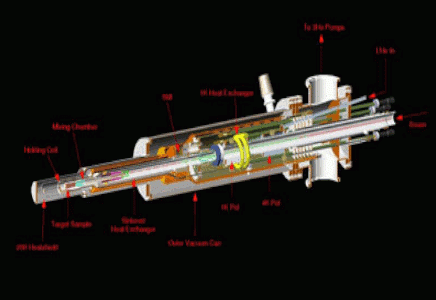The JLab Frozen Spin Target

Additional Links
Nuclear-spin polarized targets play a key role in experimental nuclear and particle physics. They are essential for understanding how the proton and neutron get their spins from their constituent quarks and gluons and for measuring the electromagnetic structure of these nucleons in both their ground and excited states. While the Jefferson Lab Frozen Spin Target (FROST) is the fourth and latest polarized target to be used at JLab, it is the first to be entirely designed and built here. FROST is designed to be used inside the CEBAF Large Acceptance Spectrometer (CLAS) with beams of real photons.
Scientists in the JLab Target Group use a microwave-based technique called dynamic nuclear polarization, or DNP, to polarize free protons (hydrogen nuclei) within a sample of frozen butanol. However, to polarize the free protons, DNP also requires a powerful superconducting magnet, which obscures a large fraction of particles scattering from the target.
To overcome this problem, the Target Group constructed one of the world's most powerful 3He-4He dilution refrigerators to cool the target to less than three hundredths of a degree above absolute zero. At such low temperatures, the polarization of the protons decays very slowly (in other words, the spins are "frozen"), and both the microwave source and the polarizing magnet can be switched off.
The sample is then removed from the polarizing magnet, and a smaller, 0.56 tesla magnet is used to "hold" the polarization during the scattering experiment. This holding magnet, integrated into the FROST cryostat, is thin enough for scattered particles to pass through and be detected by the CLAS spectrometer. Under these field and temperature conditions, the polarization decay is only about 1% per day.
FROST has already been used in Hall B for experiments with the target polarized along the direction of the photon beam. In its next use (2010), the polarization must be perpendicular to the beam. To accomplish this, the Target Group has also built a 0.54 tesla dipole magnet to rotate the spins 90º after polarization and hold them in the perpendicular direction.
References:
St. Goertz, W. Meyer, and G. Reicherz, Progr Part Nucl Phys 49 (2002) 403-489
C.D. Keith, FROST webpage

